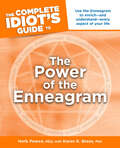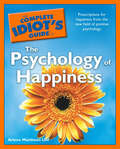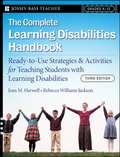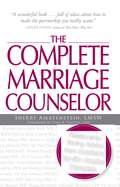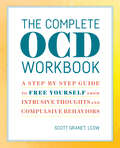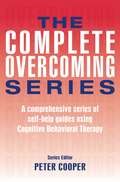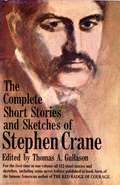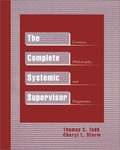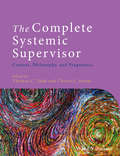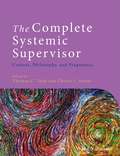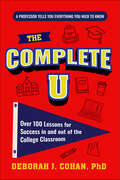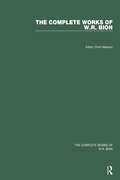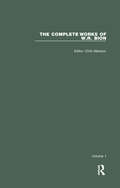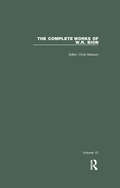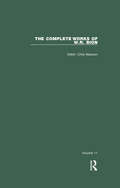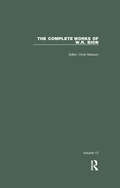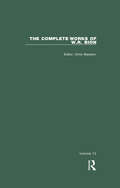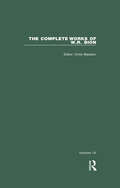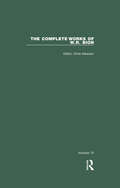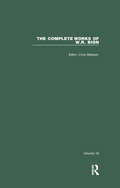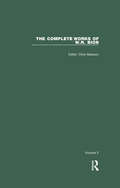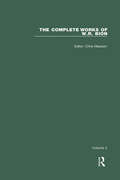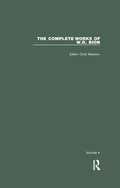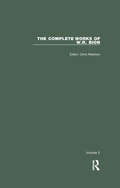- Table View
- List View
The Complete Idiot's Guide to the Power of the Enneagram
by Karen K. Brees Herb PearceEmpower yourself through through self discovery - uncover your personality type, become your best self, and learn about other personality types to improve your relationshipsIn this &‘personality guide&’, Author Laura Miltenberger covers the nine enneagram personality types. Each archetype is distinct and influences a person&’s traits, how they work, reach goals, and relate to others. Let the pages of this enneagram workbook take you on a journey of self-discovery. The book will help you: • Identify your enneagram type • Learn about the defining characteristics of each type • Find out how your personality traits can influence your daily habits and interactions • Discover how to embrace the strengths of your type and overcome your weaknesses • Improve your relationships by deepening your understanding of others Discover your personalityUnlock your potential and become your best self with this personality psychology book. This book offers a deeper understanding of the complexity of your personality. By working through the personality book, you&’ll discover your strengths and weaknesses and quickly identify ways to reach your highest potential. Enneagram archetypes are determined by a personality assessment and then each type is analyzed by their strengths and weaknesses. Through illustrations and simple explanations, the author offers guidance on how to use this knowledge for self-awareness and personal growth. This book will keep you engaged and ready to implement what you&’ve learned in no time!
The Complete Idiot's Guide to the Psychology of Happiness
by Arlene UhlLearn the secrets of happiness. You&’re no idiot, of course. You know how difficult to see the bright side of things when life seems to be a rut, much less in the face of adversity. But when you nurture a positive attitude, you also nurture your ability to find happiness in the moment—even if it doesn&’t live up to your perfect expectations. The Complete Idiot&’s Guide® to the Psychology of Happiness offers insights into human nature and techniques that will help you regain the sense of joy. In this Complete Idiot&’s Guide®, you get:• The power of optimism and humor to enhance your outlook. • The blissful benefits of engaging in playful behavior and artistic expression.• The importance of nurturing positive relationships among friends and family.• The power of exercise and meditation to simulate joyful chemical reactions within the body.
The Complete Learning Disabilities Handbook
by Joan Harwell Rebecca Williams JacksonThe third edition of this classic resource is a comprehensive source of information, strategies, and activities for working with learning disabled students. The book offers special educators, classroom teachers, and parents a wealth of new and proven suggestions and ready-to-use materials for helping LD students of all ages learn and perform at their fullest potential.
The Complete Marriage Counselor: Relationship-saving Advice from America's Top 50+ Couples Therapists
by Sherry Amatenstein• More couples than ever before are seeking relief from couples therapy (American Association of Marriage and Family Therapy) • Author is the Dating Doyenne for iVillage and writes the column &“Dating After 40&” for More magazine • Amatenstein has provided relationship advice for VHI, BBC, Lifetime, Inside Edition, Regis and Kelly, The Early Show, CBS News, and many other programs • Contributors are the most well-known marriage counselors in America, including: Dr. Judy Kuriansky, Dr. John Gray, Dr. John Gottman, Dr. Warren Farrell, Dr. Harville Hendrix, Dr. Ruth, and more Combining the best advice from the best counselors across the country—couples on the brink of divorce finally have the answers they need. Bringing this prestigious group of experts together for the first time, Sherry Amatenstein offers readers advice based on counseling sessions with real couples from around the country. By selecting the 101 most-asked questions after polling 50+ notable counselors in America, Sherry gets to the heart of the real problems couples are facing today. With questions about everything from sex and money to infidelity and communication, troubled couples will realize they&’re not alone while absorbing the best advice there is on the market today. Questions include: • I hate his family. What can I do to get out of seeing them so often? • Why does she always overspend? • How do I/do we get over an affair? • How can we stop being so bored? • Why does she treat me like I&’m the enemy? The ultimate resource for unhappy couples, The Complete Marriage Counselor features marriage-saving solutions that really work.
The Complete OCD Workbook: A Step-by-Step Guide to Free Yourself from Intrusive Thoughts and Compulsive Behaviors
by Scott Granet LCSWOCD manifests in many forms, but the only solution for treatment is to act. Applying proven therapeutic strategies to actionable exercises, The Complete OCD Workbook arms you with the tools you need to fight intrusive thoughts and compulsions and take your life back from OCD.This workbook delivers a new action-oriented approach that is designed for various types of OCD. From "Pure" (thoughts only) to compulsive behaviors, this workbook combines CBT, ERP, and mindfulness strategies into a step-by-step method for confronting intrusive thoughts and behaviors. Tracking your progress through reflective questionnaires and journal entries, this workbook offers a supportive, self-paced framework to free yourself from OCD.What you will find inside:An essential introduction that provides an overview of the primary treatment methods such as CBT, ERP, and mindfulness.Actionable exercises that use questionnaires, checklists, and reflective prompts to provide a hands-on and personalized approach to treating OCD.Real stories that offer support throughout your journey to healing, from patients who understand and have overcome struggles associated with OCD.OCD is determined—it doesn't give up easily. But you have the determination to challenge it, and that is the first of many successes you'll discover in The Complete OCD Workbook.
The Complete Overcoming Series: A comprehensive series of self-help guides using Cognitive Behavioral Therapy
by Peter CooperThe complete set of self-help guides from the popular Overcoming series. Each guide is based on Cognitive Behavioral Therapy (CBT), an evidence-based therapy which is recommended by the NHS for the treatment of a large number of psychological difficulties. Each guide comprises a step-by-step self-help programme based on CBT and contains:-Useful information about the disorder-Practical strategies and techniques based on CBT-Advice on how to keep recovery going-Further resourcesThe Complete Overcoming Series contains 31 titles:Overcoming Anger and IrritabilityOvercoming Anorexia NervosaOvercoming AnxietyOvercoming Body Image Problems including Body Dysmorphic DisorderOvercoming Bulimia Nervosa and Binge-EatingOvercoming Childhood TraumaOvercoming Chronic FatigueOvercoming Chronic PainOvercoming Compulsive GamblingOvercoming Depersonalization & Feelings of UnrealityOvercoming DepressionOvercoming GriefOvercoming Health AnxietyOvercoming Insomnia and Sleep ProblemsOvercoming Low Self-EsteemOvercoming Mood SwingsOvercoming Obsessive Compulsive DisorderOvercoming Panic and AgoraphobiaOvercoming Paranoid and Suspicious ThoughtsOvercoming PerfectionismOvercoming Problem DrinkingOvercoming Relationship ProblemsOvercoming Sexual ProblemsOvercoming Social Anxiety and ShynessOvercoming StressOvercoming Traumatic StressOvercoming Weight ProblemsOvercoming WorryOvercoming Your Child's Fears & WorriesOvercoming Your Child's Shyness and Social AnxietyOvercoming You Smoking Habit
The Complete Overcoming Series: A comprehensive series of self-help guides using Cognitive Behavioral Therapy
by Prof Peter CooperThe complete set of self-help guides from the popular Overcoming series. Each guide is based on Cognitive Behavioral Therapy (CBT), an evidence-based therapy which is recommended by the NHS for the treatment of a large number of psychological difficulties. Each guide comprises a step-by-step self-help programme based on CBT and contains:-Useful information about the disorder-Practical strategies and techniques based on CBT-Advice on how to keep recovery going-Further resourcesThe Complete Overcoming Series contains 31 titles:Overcoming Anger and IrritabilityOvercoming Anorexia NervosaOvercoming AnxietyOvercoming Body Image Problems including Body Dysmorphic DisorderOvercoming Bulimia Nervosa and Binge-EatingOvercoming Childhood TraumaOvercoming Chronic FatigueOvercoming Chronic PainOvercoming Compulsive GamblingOvercoming Depersonalization & Feelings of UnrealityOvercoming DepressionOvercoming GriefOvercoming Health AnxietyOvercoming Insomnia and Sleep ProblemsOvercoming Low Self-EsteemOvercoming Mood SwingsOvercoming Obsessive Compulsive DisorderOvercoming Panic and AgoraphobiaOvercoming Paranoid and Suspicious ThoughtsOvercoming PerfectionismOvercoming Problem DrinkingOvercoming Relationship ProblemsOvercoming Sexual ProblemsOvercoming Social Anxiety and ShynessOvercoming StressOvercoming Traumatic StressOvercoming Weight ProblemsOvercoming WorryOvercoming Your Child's Fears & WorriesOvercoming Your Child's Shyness and Social AnxietyOvercoming You Smoking Habit
The Complete Short Stories and Sketches of Stephen Crane
by Stephen Crane Thomas A. Gullason790 pages - For the first time in one volume all 112 short stories and sketches, including some never before published in book form, of the famous American author of The Red Badge of Courage.
The Complete Systemic Supervisor: Context, Philosophy, and Pragmatics
by Cheryl L. Storm Thomas C. ToddThanks to the input from numerous supervisors representing a wide variety of settings, theoretical models and backgrounds, this has become the definitive text on clinical supervision from a systemic perspective. It contains a wealth of material for beginning and experienced supervisors, regardless of theoretical persuasion. It is suitable as a text on MFT supervision or for a prominent place on the bookshelf of practicing supervisors.
The Complete Systemic Supervisor: Context, Philosophy, and Pragmatics
by Cheryl L. Storm Thomas C. ToddThe Second Edition of the definitive text on systemic clinical supervision has been fully updated and now includes a range of practical online resources. New edition of the definitive text on systemic clinical supervision, fully updated and revised, with a wealth of case studies throughout Supported by a range of practical online resources New material includes coverage of systemic supervision outside MFT and international training contexts – such as healthcare, schools and the military Top-level contributors include those practicing academic, agency, and privately contracted supervision with novice to experienced therapists The editors received a prestigious award in 2015 from the American Family Therapy Academy for their contribution to systemic supervision theory and practice
The Complete Systemic Supervisor: Context, Philosophy, and Pragmatics (Second Edition)
by Cheryl L. Storm Thomas C. ToddThis book presents in-depth discussions in systemic supervision of such areas as the interface of supervision and social identities like social class and sexual orientation, supervision ethics, contracting, supervision models associated with the predominant models of systemic therapy, and training of supervisors.
The Complete U: Over 100 Lessons for Success in and out of the College Classroom
by Deborah J. CohanThe Only College Guide You'll Ever NeedFind Meaning, Growth, and Joy in Your College JourneyThe Complete U is a supportive, real-world guide to thriving in college—academically, socially, and emotionally. With warmth, humor, and deep insight, Dr. Deborah J. Cohan delivers over 100 empowering lessons to help students navigate every aspect of campus life.The Complete U is your empowering, honest, and compassionate guide to navigating every step of the college experience. With over 100 lessons from sociologist and beloved professor Dr. Deborah J. Cohan, this transformative book offers the wisdom, support, and practical strategies every student needs to succeed in and beyond the classroom. Whether you&’re a first-year student or preparing to graduate, this book is like a trusted mentor, cheering you on while offering real talk about everything from picking a major to building mental resilience. From managing course loads and professors to making friends, coping with anxiety, and defining your purpose, The Complete U helps you grow not only as a student—but as a person. Inside, you&’ll find: Practical advice for every aspect of college life—from homesickness and time management to healthy relationships and stress relief. Supportive lessons for mental, emotional, and academic well-being, especially tailored to modern challenges like social media burnout, identity, and uncertainty. Lively reflections and real stories from students and parents, offering encouragement and insight in equal measure. Your College Compass and Survival ToolkitIf you liked The Anxious Generation, The Freshman Survival Guide, or The Naked Roommate, then you'll love The Complete U.
The Complete Works of W.R. Bion: All Volumes (The Complete Works of W.R. Bion)
by W. R. BionThe Complete Works of W. R. Bion is now available in a coherent and corrected format. Comprising sixteen volumes bound in green cloth, this edition has been brought together and edited by Chris Mawson with the assistance of Francesca Bion. Incorporating many corrections to previously published works, it also features previously unpublished papers. Including a general index and editorial introductions to all the works, these volumes will be a useful and valuable aid to psychoanalytic scholars and clinicians, and all those interested in studying and making use of Bion's thinking.Bion's writings, including the previously unpublished papers and additions to his Cogitations, collected together in the Complete Works, show that the clinical thrust of Bion's work has clear lines of continuity with that of Melanie Klein, just as her work has an essential continuity with the later work of Freud. In Bion's clinical work and supervision the goal remains insightful understanding of psychic reality through a disciplined experiencing of the transference and countertransference; the setting and the method - however much Bion's terminology might suggest otherwise - remains rigorously psychoanalytic.
The Complete Works of W.R. Bion: Volume 1 (The\complete Works Of W. R. Bion Ser.)
by W.R BionThis book is a reminiscence of the first twenty-one years of the Wilfred R. Bion's life from 1897 to 1919: eight years of childhood in India, ten years at public school in England, and three years in the army.
The Complete Works of W.R. Bion: Volume 10 (The\complete Works Of W. R. Bion Ser.)
by W. R. BionThis volume is a collection of papers containing talks given by Bion at meetings of the Los Angeles Psychoanalytic Society, discussions covering the main features of Bion's model of the mind and his view of the psychoanalyst at work, and an illuminating interview of Bion by Anthony G. Banet in 1976.
The Complete Works of W.R. Bion: Volume 11 (The Complete Works of W.R. Bion)
by W. R. BionCogitations is the name Bion gave to the occasional short notes he had begun to write in the February of 1958 in order to clarify his think-ing about the difficulties of working with psychotic patients using an unmodified psychoanalytic method – work informed by and shared with his two closest colleagues (who, like Bion, were in analysis with Melanie Klein), Hanna Segal and Herbert Rosenfeld. That clinical work formed the foundation of the clinical papers reproduced in Second Thoughts and the formulations in the four books of the 1960s: Learning from Expe-rience, Elements of Psycho-Analysis, Transformations, and Attention and Interpretation.
The Complete Works of W.R. Bion: Volume 12 (The\complete Works Of W. R. Bion Ser.)
by W. R. BionA figurative and free-ranging psychoanalytic novel was not something Bion would have felt free to write and – more to the point – to publish had he and his wife, Francesca, not moved to Los Angeles, which they did in 1968. Once there, Bion set about adjusting to the new culture, establishing links with the analysts who had invited him, and setting up an analytic practice. He also began work on a book, which he called The Dream, published in 1975. Two years later he added The Past Pre-sented, and in 1979 – with the addition of The Dawn of Oblivion – the novel had become a trilogy. In 1991, at the instigation of Francesca Bion, the three were finally published in one volume, with corrections, together with an enlarged version of A Key to A Memoir of the Future, which had first been published in 1981. Francesca Bion has described the Memoir asa fictionalised, dramatised presentation of a lifetime’s experiences, filled with a crowd of character; voicing the many facets of his own personality and thought; at the same time we recognise ourselves among the dramatis personae.
The Complete Works of W.R. Bion: Volume 13
by W. R. BionThis volume provides a detailed account of The Past Presented, one of three semi-autobiographical novels in the collection A Memoir of the Future, an attempt to cast psychoanalytic speculation in fictional form.
The Complete Works of W.R. Bion: Volume 14
by W. R. BionThis book provides an account of The Dawn of Oblivion, one of three semi-autobiographical novels in the collection A Memoir of the Future, an attempt to cast psychoanalytic speculation in fictional form. It includes an expanded version of A Key to A Memoir of the Future (1981).
The Complete Works of W.R. Bion: Volume 15 (The Complete Works of W.R. Bion)
by W. R. BionThe previously unpublished works by Bion included in this volume com-prise four papers and ‘Further Cogitations’ from 1968 to 1969.The first of the papers has the title, ‘The Conception of Man‘. It was written originally as a chapter for a planned book of the same title, to be edited by Arthur Burton, who also edited Psychotherapy of the Psycho-ses (1961). Bion had been recommended as a possible contributor to the book by John Harvard-Watts – who had, around that time, suggested to Francesca Bion that she might persuade her husband to publish as a book the papers of Experiences in Groups and Other Papers (1961). Burton’s book was to have clarified how different thinkers conceived of Man, ”in his basic nature and humanity.
The Complete Works of W.R. Bion: Volume 16 (The Complete Works of W.R. Bion)
by W. R. BionThe Complete Works of W. R. Bion is now available in a coherent and corrected format. Comprising sixteen volumes bound in green cloth, this edition has been brought together and edited by Chris Mawson with the assistance of Francesca Bion. Incorporating many corrections to previously published works, it also features previously unpublished papers.
The Complete Works of W.R. Bion: Volume 2 (The\complete Works Of W. R. Bion Ser.)
by W. R. BionThis volume provides a detailed account of All My Sins Remembered, a continuation of Wilfred R. Bion's autobiography, The Long Week-end. It also includes a selection of his letters to Francesca, Parthenope, Julian and Nicola, written during his last thirty years.
The Complete Works of W.R. Bion: Volume 3 (The Complete Works of W.R. Bion)
by W. R. BionThis volume, hand-written and contained in three hardbound notebooks, is Wilfred R. Bion's factual record of his war service in France in the Royal Tank Regiment between June 1917 and January 1919, written soon after he went up to The Queen's College, Oxford, after demobilized from the Army.
The Complete Works of W.R. Bion: Volume 4 (The\complete Works Of W. R. Bion Ser.)
by W. R. BionThe Complete Works of W. R. Bion is now available in a coherent and corrected format. Comprising sixteen volumes bound in green cloth, this edition has been brought together and edited by Chris Mawson with the assistance of Francesca Bion. Incorporating many corrections to previously published works, it also features previously unpublished papers.
The Complete Works of W.R. Bion: Volume 5 (The\complete Works Of W. R. Bion Ser.)
by W. R. BionThis volume contains articles that focus on categorising the ideational context and emotional experience that may occur in a psychoanalytic interview and that examine the way in which an analyst's description of the analytic experience necessarily transforms it, in order to effect an interpretation.
